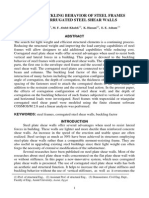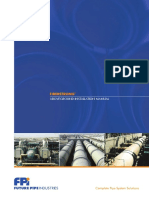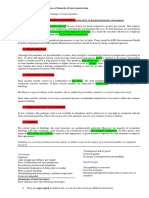Ansys Shell 63 Elementansys Shell 63 Elementansys Shell 63 Element
Ansys Shell 63 Elementansys Shell 63 Elementansys Shell 63 Element
Uploaded by
vilukCopyright:
Available Formats
Ansys Shell 63 Elementansys Shell 63 Elementansys Shell 63 Element
Ansys Shell 63 Elementansys Shell 63 Elementansys Shell 63 Element
Uploaded by
vilukOriginal Title
Copyright
Available Formats
Share this document
Did you find this document useful?
Is this content inappropriate?
Copyright:
Available Formats
Ansys Shell 63 Elementansys Shell 63 Elementansys Shell 63 Element
Ansys Shell 63 Elementansys Shell 63 Elementansys Shell 63 Element
Uploaded by
vilukCopyright:
Available Formats
SHELL63
http://www.et.byu.edu/docs/ansys/ansys8.0/Hlp_E_SHELL63.html
Element Reference> Part I. Element Library>
SHELL63
MP ME ST <> <> PR <> <> <> PP ED
SHELL63 Elastic Shell
SHELL63 Element Description
SHELL63 has both bending and membrane capabilities. Both in-plane and normal loads are permitted. The element has six degrees of freedom at each node: translations in the nodal x, y, and z directions and rotations about the nodal x, y, and z-axes. Stress stiffening and large deflection capabilities are included. A consistent tangent stiffness matrix option is available for use in large deflection (finite rotation) analyses. See SHELL63 in the ANSYS, Inc. Theory Reference for more details about this element. Similar elements are SHELL43 and SHELL181 (plastic capability), and SHELL93 (midside node capability). The ETCHG command converts SHELL57 and SHELL157 elements to SHELL63. Figure 63.1 SHELL63 Geometry
xIJ = Element x-axis if ESYS is not supplied. x = Element x-axis if ESYS is supplied.
SHELL63 Input Data
The geometry, node locations, and the coordinate system for this element are shown in Figure 63.1: "SHELL63 Geometry". The element is defined by four nodes, four thicknesses, an elastic foundation stiffness, and the orthotropic material properties. Orthotropic material directions correspond to the element coordinate directions. The element coordinate system orientation is as described in Coordinate Systems. The element x-axis may be rotated by an angle THETA (in degrees).
1 of 10
12/6/07 11:29 PM
SHELL63
http://www.et.byu.edu/docs/ansys/ansys8.0/Hlp_E_SHELL63.html
The thickness is assumed to vary smoothly over the area of the element, with the thickness input at the four nodes. If the element has a constant thickness, only TK(I) need be input. If the thickness is not constant, all four thicknesses must be input. The elastic foundation stiffness (EFS) is defined as the pressure required to produce a unit normal deflection of the foundation. The elastic foundation capability is bypassed if EFS is less than, or equal to, zero. For certain nonhomogeneous or sandwich shell applications, the following real constants are provided: RMI is the ratio of the bending moment of inertia to be used to that calculated from the input thicknesses. RMI defaults to 1.0. CTOP and CBOT are the distances from the middle surface to the extreme fibers to be used for stress evaluations. Both CTOP and CBOT are positive, assuming that the middle surface is between the fibers used for stress evaluation. If not input, stresses are based on the input thicknesses. ADMSUA is the added mass per unit area. Element loads are described in Node and Element Loads. Pressures may be input as surface loads on the element faces as shown by the circled numbers on Figure 63.1: "SHELL63 Geometry". Positive pressures act into the element. Edge pressures are input as force per unit length. The lateral pressure loading may be an equivalent (lumped) element load applied at the nodes (KEYOPT(6) = 0) or distributed over the face of the element (KEYOPT(6) = 2). The equivalent element load produces more accurate stress results with flat elements representing a curved surface or elements supported on an elastic foundation since certain fictitious bending stresses are eliminated. Temperatures may be input as element body loads at the "corner" locations (1-8) shown in Figure 63.1: "SHELL63 Geometry". The first corner temperature T1 defaults to TUNIF. If all other temperatures are unspecified, they default to T1. If only T1 and T2 are input, T1 is used for T1, T2, T3, and T4, while T2 (as input) is used for T5, T6, T7, and T8. For any other input pattern, unspecified temperatures default to TUNIF. KEYOPT(1) is available for neglecting the membrane stiffness or the bending stiffness, if desired. A reduced out-of-plane mass matrix is also used when the bending stiffness is neglected. KEYOPT(2) is used to activate the consistent tangent stiffness matrix (that is, a matrix composed of the main tangent stiffness matrix plus the consistent stress stiffness matrix) in large deflection analyses [NLGEOM,ON]. You can often obtain more rapid convergence in a geometrically nonlinear analysis, such as a nonlinear buckling or postbuckling analysis, by activating this option. However, you should not use this option if you are using the element to simulate a rigid link or a group of coupled nodes. The resulting abrupt changes in stiffness within the structure make the consistent tangent stiffness matrix unsuitable for such applications. KEYOPT(3) allows you to include (KEYOPT(3) = 0 or 2) or suppress (KEYOPT(3) = 1) extra displacement shapes. It also allows you to choose the type of in-plane rotational stiffness used: KEYOPT(3) = 0 or 1 activates a spring-type in-plane rotational stiffness about the element z-axis KEYOPT(3) = 2 activates a more realistic in-plane rotational stiffness (Allman rotational stiffness - the program uses default penalty parameter values of d1 = 1.0E-6 and d2 = 1.0E-3). Using the Allman stiffness will often enhance convergence behavior in large deflection (finite rotation) analyses of planar shell structures (that is, flat shells or flat regions of shells). KEYOPT(7) allows a reduced mass matrix formulation (rotational degrees of freedom terms deleted). This option is useful for improved bending stresses in thin members under mass loading.
2 of 10
12/6/07 11:29 PM
SHELL63
http://www.et.byu.edu/docs/ansys/ansys8.0/Hlp_E_SHELL63.html
KEYOPT(8) allows a reduced stress stiffness matrix (rotational degrees of freedom deleted). This option can be useful for calculating improved mode shapes and a more accurate load factor in linear buckling analyses of certain curved shell structures. KEYOPT(11) = 2 is used to store midsurface results in the results file for single or multi-layer shell elements. If you use SHELL,MID, you will see these calculated values, rather than the average of the TOP and BOTTOM results. You should use this option to access these correct midsurface results (membrane results) for those analyses where averaging TOP and BOTTOM results is inappropriate; examples include midsurface stresses and strains with nonlinear material behavior, and midsurface results after mode combinations that involve squaring operations such as in spectrum analyses. A summary of the element input is given in "SHELL63 Input Summary". A general description of element input is given in Element Input.
SHELL63 Input Summary
Nodes I, J, K, L Degrees of Freedom UX, UY, UZ, ROTX, ROTY, ROTZ Real Constants TK(I), TK(J), TK(K), TK(L), EFS, THETA, RMI, CTOP, CBOT, (Blank), (Blank), (Blank), (Blank), (Blank), (Blank), (Blank), (Blank), (Blank), ADMSUA See Table 63.1: "SHELL63 Real Constants" for a description of the real constants Material Properties EX, EY, EZ, (PRXY, PRYZ, PRXZ or NUXY, NUYZ, NUXZ), ALPX, ALPY, ALPZ (or CTEX, CTEY, CTEZ or THSX, THSY, THSZ), DENS, GXY, DAMP Surface Loads Pressures -face 1 (I-J-K-L) (bottom, in +Z direction), face 2 (I-J-K-L) (top, in -Z direction), face 3 (J-I), face 4 (K-J), face 5 (L-K), face 6 (I-L) Body Loads Temperatures -T1, T2, T3, T4, T5, T6, T7, T8 Special Features Stress stiffening Large deflection Birth and death KEYOPT(1) Element stiffness:
3 of 10
12/6/07 11:29 PM
SHELL63
http://www.et.byu.edu/docs/ansys/ansys8.0/Hlp_E_SHELL63.html
0 -Bending and membrane stiffness 1 -Membrane stiffness only 2 -Bending stiffness only KEYOPT(2) Stress stiffening option: 0 -Use only the main tangent stiffness matrix when NLGEOM is ON. (Stress stiffening effects used in linear buckling or other linear prestressed analyses must be activated separately with PSTRES,ON.) 1 -Use the consistent tangent stiffness matrix (that is, a matrix composed of the main tangent stiffness matrix plus the consistent stress stiffness matrix) when NLGEOM is ON and when KEYOPT(1) = 0. (SSTIF,ON will be ignored for this element when KEYOPT(2) = 1 is activated.) Note that if SOLCONTROL is ON and NLGEOM is ON, KEYOPT(2) is automatically set to 1; that is, the consistent tangent will be used. 2 -Use to turn off consistent tangent stiffness matrix (i.e., a matrix composed of the main tangent stiffness matrix plus the consistent stress stiffness matrix) when SOLCONTROL is ON. Sometimes it is necessary to turn off the consistent tangent stiffness matrix if the element is used to simulate rigid bodies by using a very large real constant number . KEYOPT(2) = 2 is the same as KEYOPT(2) = 0, however, KEYOPT(2) = 0 is controlled by SOLCONTROL, ON or OFF, while KEYOPT(2) = 2 is independent of SOLCONTROL. KEYOPT(3) Extra displacement shapes: 0 -Include extra displacement shapes, and use spring-type in-plane rotational stiffness about the element z-axis (the program automatically adds a small stiffness to prevent numerical instability for non-warped elements if KEYOPT(1) = 0).
Note
For models with large rotation about the in-plane direction, KEYOPT(3) = 0 results in some transfer of moment directly to ground. 1 --
4 of 10
12/6/07 11:29 PM
SHELL63
http://www.et.byu.edu/docs/ansys/ansys8.0/Hlp_E_SHELL63.html
Suppress extra displacement shapes, and use spring-type in-plane rotational stiffness about the element z-axis (the program automatically adds a small stiffness to prevent numerical instability for non-warped elements if KEYOPT(1) = 0). 2 -Include extra displacement shapes, and use the Allman in-plane rotational stiffness about the element z-axis). See the ANSYS, Inc. Theory Reference. KEYOPT(5) Extra stress output: 0 -Basic element printout 2 -Nodal stress printout KEYOPT(6) Pressure loading: 0 -Reduced pressure loading (must be used if KEYOPT(1) = 1) 2 -Consistent pressure loading KEYOPT(7) Mass matrix: 0 -Consistent mass matrix 1 -Reduced mass matrix KEYOPT(8) Stress stiffness matrix: 0 -Nearly consistent stress stiffness matrix (default) 1 -Reduced stress stiffness matrix KEYOPT(9)
5 of 10
12/6/07 11:29 PM
SHELL63
http://www.et.byu.edu/docs/ansys/ansys8.0/Hlp_E_SHELL63.html
Element coordinate system defined: 0 -No user subroutine to define element coordinate system 4 -Element x-axis located by user subroutine USERAN
Note
See the Guide to ANSYS User Programmable Features for user written subroutines KEYOPT(11) Specify data storage: 0 -Store data for TOP and BOTTOM surfaces only 2 -Store data for TOP, BOTTOM, and MID surfaces Table 63.1 SHELL63 Real Constants No. 1 2 3 4 5 6 7 8 9 10, ..., 18 19 TK(I) TK(J) TK(K) TK(L) EFS THETA RMI CTOP CBOT (Blank) ADMSUA Name Shell thickness at node I Shell thickness at node J Shell thickness at node K Shell thickness at node L Elastic foundation stiffness Element X-axis rotation Bending moment of inertia ratio Distance from mid surface to top Distance from mid surface to bottom -Added mass/unit area Description
SHELL63 Output Data
The solution output associated with the element is in two forms: Nodal displacements included in the overall nodal solution
6 of 10
12/6/07 11:29 PM
SHELL63
http://www.et.byu.edu/docs/ansys/ansys8.0/Hlp_E_SHELL63.html
Additional element output as shown in Table 63.2: "SHELL63 Element Output Definitions" Several items are illustrated in Figure 63.2: "SHELL63 Stress Output". Printout includes the moments about the x face (MX), the moments about the y face (MY), and the twisting moment (MXY). The moments are calculated per unit length in the element coordinate system. The element stress directions are parallel to the element coordinate system. A general description of solution output is given in Solution Output. See the ANSYS Basic Analysis Guide for ways to view results. Figure 63.2 SHELL63 Stress Output
xIJ = Element x-axis if ESYS is not supplied. x = Element x-axis if ESYS is supplied. The Element Output Definitions table uses the following notation: A colon (:) in the Name column indicates the item can be accessed by the Component Name method [ETABLE, ESOL]. The O column indicates the availability of the items in the file Jobname.OUT. The R column indicates the availability of the items in the results file. In either the O or R columns, Y indicates that the item is always available, a number refers to a table footnote that describes when the item is conditionally available, and a - indicates that the item is not available. Table 63.2 SHELL63 Element Output Definitions Name EL NODES MAT Element Number Nodes - I, J, K, L Material number Definition O Y Y Y R Y Y Y
7 of 10
12/6/07 11:29 PM
SHELL63
http://www.et.byu.edu/docs/ansys/ansys8.0/Hlp_E_SHELL63.html
Name AREA XC, YC, ZC PRES TEMP T(X, Y, XY) M(X, Y, XY) FOUND.PRESS LOC S:X, Y, Z, XY S:1, 2, 3 S:INT S:EQV EPEL:X, Y, Z, XY EPEL:EQV EPTH:X, Y, Z, XY EPTH:EQV AREA
Definition
O Y Y Y Y Y Y Y Y Y Y Y Y Y Y Y Y Y Y Y Y Y 1
R Y
Location where results are reported Pressures P1 at nodes I, J, K, L; P2 at I, J, K, L; P3 at J, I; P4 at K, J; P5 at L, K; P6 at I, L Temperatures T1, T2, T3, T4, T5, T6, T7, T8 In-plane element X, Y, and XY forces Element X, Y, and XY moments Foundation pressure (if nonzero) Top, middle, or bottom Combined membrane and bending stresses Principal stress Stress intensity Equivalent stress Average elastic strain Equivalent elastic strain [2] Average thermal strain Equivalent thermal strain [2]
Y Y Y Y Y Y
1. Available only at centroid as a *GET item. 2. The equivalent strains use an effective Poisson's ratio: for elastic and thermal this value is set by the user (MP,PRXY). Table 63.3 SHELL63 Miscellaneous Element Output Description Nodal Stress Solution Names of Items Output TEMP, S(X, Y, Z, XY), SINT, SEQV 1 O R -
1. Output at each node, if KEYOPT(5) = 2, repeats each location Table 63.4: "SHELL63 Item and Sequence Numbers" lists output available through the ETABLE command using the Sequence Number method. See The General Postprocessor (POST1) in the ANSYS Basic Analysis Guide and The Item and Sequence Number Table in this manual for more information. The following notation is used in Table 63.4: "SHELL63 Item and Sequence Numbers": Name output quantity as defined in the Table 63.2: "SHELL63 Element Output Definitions" Item predetermined Item label for ETABLE command
8 of 10
12/6/07 11:29 PM
SHELL63
http://www.et.byu.edu/docs/ansys/ansys8.0/Hlp_E_SHELL63.html
E sequence number for single-valued or constant element data I,J,K,L sequence number for data at nodes I,J,K,L Table 63.4 SHELL63 Item and Sequence Numbers Output Quantity Name TX TY TXY MX MY MXY P1 P2 P3 P4 P5 P6 Top S:1 S:2 S:3 S:INT S:EQV Bot S:1 S:2 S:3 S:INT S:EQV NMISC NMISC NMISC NMISC NMISC 21 22 23 24 25 26 27 28 29 30 31 32 33 34 35 36 37 38 39 40 NMISC NMISC NMISC NMISC NMISC 1 2 3 4 5 6 7 8 9 10 11 12 13 14 15 16 17 18 19 20 ETABLE and ESOL Command Input Item SMISC SMISC SMISC SMISC SMISC SMISC SMISC SMISC SMISC SMISC SMISC SMISC 1 2 3 4 5 6 23 9 13 18 E I 10 14 17 20 19 22 21 24 J 11 15 K 12 16 L -
SHELL63 Assumptions and Restrictions
9 of 10
12/6/07 11:29 PM
SHELL63
http://www.et.byu.edu/docs/ansys/ansys8.0/Hlp_E_SHELL63.html
Zero area elements are not allowed. This occurs most often whenever the elements are not numbered properly. Zero thickness elements or elements tapering down to a zero thickness at any corner are not allowed. The applied transverse thermal gradient is assumed to vary linearly through the thickness and vary bilinearly over the shell surface. An assemblage of flat shell elements can produce a good approximation of a curved shell surface provided that each flat element does not extend over more than a 15 arc. If an elastic foundation stiffness is input, one-fourth of the total is applied at each node. Shear deflection is not included in this thin-shell element. A triangular element may be formed by defining duplicate K and L node numbers as described in Triangle, Prism and Tetrahedral Elements. The extra shapes are automatically deleted for triangular elements so that the membrane stiffness reduces to a constant strain formulation. For large deflection analyses, if KEYOPT(1) = 1 (membrane stiffness only), the element must be triangular. For KEYOPT(1) = 0 or 2, the four nodes defining the element should lie as close as possible to a flat plane (for maximum accuracy), but a moderate amount of warping is permitted. For KEYOPT(1) = 1, the warping limit is very restrictive. In either case, an excessively warped element may produce a warning or error message. In the case of warping errors, triangular elements should be used (see Triangle, Prism and Tetrahedral Elements). Shell element warping tests are described in detail in tables of Applicability of Warping Tests and Warping Factor Limits in the ANSYS, Inc. Theory Reference. If the lumped mass matrix formulation is specified [LUMPM,ON], the effect of the implied offsets on the mass matrix is ignored for warped SHELL63 elements.
SHELL63 Product Restrictions
When used in the product(s) listed below, the stated product-specific restrictions apply to this element in addition to the general assumptions and restrictions given in the previous section. ANSYS Professional. The DAMP material property is not allowed. The only special features allowed are stress stiffening and large deflection. KEYOPT(2) can only be set to 0 (default). KEYOPT(9) can only be set to 0 (default).
10 of 10
12/6/07 11:29 PM
You might also like
- The Subtle Art of Not Giving a F*ck: A Counterintuitive Approach to Living a Good LifeFrom EverandThe Subtle Art of Not Giving a F*ck: A Counterintuitive Approach to Living a Good LifeRating: 4 out of 5 stars4/5 (6018)
- The Gifts of Imperfection: Let Go of Who You Think You're Supposed to Be and Embrace Who You AreFrom EverandThe Gifts of Imperfection: Let Go of Who You Think You're Supposed to Be and Embrace Who You AreRating: 4 out of 5 stars4/5 (1113)
- Never Split the Difference: Negotiating As If Your Life Depended On ItFrom EverandNever Split the Difference: Negotiating As If Your Life Depended On ItRating: 4.5 out of 5 stars4.5/5 (909)
- Hidden Figures: The American Dream and the Untold Story of the Black Women Mathematicians Who Helped Win the Space RaceFrom EverandHidden Figures: The American Dream and the Untold Story of the Black Women Mathematicians Who Helped Win the Space RaceRating: 4 out of 5 stars4/5 (937)
- Grit: The Power of Passion and PerseveranceFrom EverandGrit: The Power of Passion and PerseveranceRating: 4 out of 5 stars4/5 (619)
- Shoe Dog: A Memoir by the Creator of NikeFrom EverandShoe Dog: A Memoir by the Creator of NikeRating: 4.5 out of 5 stars4.5/5 (546)
- The Hard Thing About Hard Things: Building a Business When There Are No Easy AnswersFrom EverandThe Hard Thing About Hard Things: Building a Business When There Are No Easy AnswersRating: 4.5 out of 5 stars4.5/5 (358)
- Her Body and Other Parties: StoriesFrom EverandHer Body and Other Parties: StoriesRating: 4 out of 5 stars4/5 (831)
- Elon Musk: Tesla, SpaceX, and the Quest for a Fantastic FutureFrom EverandElon Musk: Tesla, SpaceX, and the Quest for a Fantastic FutureRating: 4.5 out of 5 stars4.5/5 (479)
- The Emperor of All Maladies: A Biography of CancerFrom EverandThe Emperor of All Maladies: A Biography of CancerRating: 4.5 out of 5 stars4.5/5 (275)
- The Little Book of Hygge: Danish Secrets to Happy LivingFrom EverandThe Little Book of Hygge: Danish Secrets to Happy LivingRating: 3.5 out of 5 stars3.5/5 (434)
- The World Is Flat 3.0: A Brief History of the Twenty-first CenturyFrom EverandThe World Is Flat 3.0: A Brief History of the Twenty-first CenturyRating: 3.5 out of 5 stars3.5/5 (2281)
- The Yellow House: A Memoir (2019 National Book Award Winner)From EverandThe Yellow House: A Memoir (2019 National Book Award Winner)Rating: 4 out of 5 stars4/5 (99)
- The Sympathizer: A Novel (Pulitzer Prize for Fiction)From EverandThe Sympathizer: A Novel (Pulitzer Prize for Fiction)Rating: 4.5 out of 5 stars4.5/5 (125)
- Devil in the Grove: Thurgood Marshall, the Groveland Boys, and the Dawn of a New AmericaFrom EverandDevil in the Grove: Thurgood Marshall, the Groveland Boys, and the Dawn of a New AmericaRating: 4.5 out of 5 stars4.5/5 (273)
- A Heartbreaking Work Of Staggering Genius: A Memoir Based on a True StoryFrom EverandA Heartbreaking Work Of Staggering Genius: A Memoir Based on a True StoryRating: 3.5 out of 5 stars3.5/5 (233)
- Team of Rivals: The Political Genius of Abraham LincolnFrom EverandTeam of Rivals: The Political Genius of Abraham LincolnRating: 4.5 out of 5 stars4.5/5 (235)
- On Fire: The (Burning) Case for a Green New DealFrom EverandOn Fire: The (Burning) Case for a Green New DealRating: 4 out of 5 stars4/5 (75)
- FE-based Vehicle Analysis of Heavy TrucksDocument10 pagesFE-based Vehicle Analysis of Heavy TrucksvilukNo ratings yet
- Step by Step Procedure To Export A Deformed Geometry in AnsysDocument11 pagesStep by Step Procedure To Export A Deformed Geometry in AnsysvilukNo ratings yet
- The Unwinding: An Inner History of the New AmericaFrom EverandThe Unwinding: An Inner History of the New AmericaRating: 4 out of 5 stars4/5 (45)
- Aisc13 PDFDocument448 pagesAisc13 PDFCarlos Abascal Mendoza100% (1)
- MOSIL TDS SPRAY 55MDocument2 pagesMOSIL TDS SPRAY 55MvilukNo ratings yet
- Model Operational DataDocument10 pagesModel Operational DatavilukNo ratings yet
- How To Post-Process Real and Imaginary Results From A Harmonic Analysis?Document1 pageHow To Post-Process Real and Imaginary Results From A Harmonic Analysis?vilukNo ratings yet
- How To Post-Process Real and Imaginary Results From A Harmonic Analysis?Document1 pageHow To Post-Process Real and Imaginary Results From A Harmonic Analysis?vilukNo ratings yet
- EG2101-L21a RT2014 PDFDocument23 pagesEG2101-L21a RT2014 PDFvilukNo ratings yet
- 05 Astm Grain Size MeasurementsDocument27 pages05 Astm Grain Size MeasurementsnareshNo ratings yet
- Carbon Black: Professor Joe Greene Csu, ChicoDocument13 pagesCarbon Black: Professor Joe Greene Csu, Chicoviluk100% (1)
- Refrigerator Installation Guide IFB Refrigerator Installation Guide IFBDocument24 pagesRefrigerator Installation Guide IFB Refrigerator Installation Guide IFBvilukNo ratings yet
- VNSine On Sine TestingDocument2 pagesVNSine On Sine TestingvilukNo ratings yet
- Design of Experiments TutorialDocument16 pagesDesign of Experiments TutorialvilukNo ratings yet
- Analysis of Acoustic Characteristics of The MufflerAnalysis of Acoustic Characteristics of The MufflerDocument6 pagesAnalysis of Acoustic Characteristics of The MufflerAnalysis of Acoustic Characteristics of The MufflervilukNo ratings yet
- Harmonic and Random Vibration DurabilityDocument238 pagesHarmonic and Random Vibration Durabilityviluk100% (1)
- Harmonic and Random Vibration DurabilityDocument238 pagesHarmonic and Random Vibration Durabilityviluk100% (1)
- Buckling Analysis K Value CalculatorDocument3 pagesBuckling Analysis K Value Calculatorrodriguez.gaytanNo ratings yet
- Elastic Buckling Behavior of Steel Frames With Corrugated Steel Shear Wall 20-12-2004Document16 pagesElastic Buckling Behavior of Steel Frames With Corrugated Steel Shear Wall 20-12-2004EliyaHeninNo ratings yet
- ESASteel - Buckling CoefficientsDocument2 pagesESASteel - Buckling CoefficientsikarnezisNo ratings yet
- IS800 - 2007 - Tube - Detailed Calculation PDFDocument4 pagesIS800 - 2007 - Tube - Detailed Calculation PDFSuresh Babu kataNo ratings yet
- 3.1.5.1 Louver DesignDocument3 pages3.1.5.1 Louver DesignNorman Christopher PalomoNo ratings yet
- Soil Short Questions 1Document8 pagesSoil Short Questions 1YasirNo ratings yet
- SN017a-En-EU-Shear Resistance of A Fin Plate ConnectionDocument13 pagesSN017a-En-EU-Shear Resistance of A Fin Plate Connectionravi balajiNo ratings yet
- A Study On Conceptual Structural Design of Fuselage For A Small Scale Wig Vehicle Using Composite MaterialsDocument8 pagesA Study On Conceptual Structural Design of Fuselage For A Small Scale Wig Vehicle Using Composite Materialskats2404No ratings yet
- Nonlocal Theories For Bending, Buckling and Vibration of Beams - JN ReddyDocument21 pagesNonlocal Theories For Bending, Buckling and Vibration of Beams - JN ReddyShivareddy KondakindiNo ratings yet
- 3D Buckling Analysis of A Truss With Horizontal BracesDocument10 pages3D Buckling Analysis of A Truss With Horizontal BracesWojtek SNo ratings yet
- CE 16 Timber Midterm 2020Document3 pagesCE 16 Timber Midterm 2020Angelo VilleroNo ratings yet
- What Are Buckling Restrained Braces?Document1 pageWhat Are Buckling Restrained Braces?Vikas MouryaNo ratings yet
- FRP Above Ground Installation ManualDocument32 pagesFRP Above Ground Installation ManualCarlos GutierrezNo ratings yet
- Snubbing PDFDocument134 pagesSnubbing PDFmjm_1365100% (2)
- B.1. Tables of Dimensions and Gross Section PropertiesDocument9 pagesB.1. Tables of Dimensions and Gross Section PropertiesGregory MillerNo ratings yet
- Distorsion Corrective TechniquesDocument4 pagesDistorsion Corrective TechniquesMathew RodriguezNo ratings yet
- Barbero Curriculum VitaeDocument23 pagesBarbero Curriculum Vitaemesfin DemiseNo ratings yet
- Buckling of Thin Metal Shells 155Document1 pageBuckling of Thin Metal Shells 155pawkomNo ratings yet
- The Mems Design Process: Dr. T. RameshDocument19 pagesThe Mems Design Process: Dr. T. RameshJackNo ratings yet
- 05 - Stress Optimization of Aircraft Fuselage FrameDocument6 pages05 - Stress Optimization of Aircraft Fuselage FrameAeronautical Engineering HODNo ratings yet
- Building Construction I - REPORTDocument46 pagesBuilding Construction I - REPORTMuhammad NazmiNo ratings yet
- ch7 - Pile Foundation - DR Zaid - Part 2Document14 pagesch7 - Pile Foundation - DR Zaid - Part 2Ahmed AlaaNo ratings yet
- The Theory of Tube Producing MethodsDocument16 pagesThe Theory of Tube Producing MethodsJosé B. CorreaNo ratings yet
- Course Outline Cc505Document5 pagesCourse Outline Cc505Adron LimNo ratings yet
- Compressive Properties of Polymer Matrix Composite Materials With Unsupported Gage Section by Shear LoadingDocument16 pagesCompressive Properties of Polymer Matrix Composite Materials With Unsupported Gage Section by Shear LoadingMaxNo ratings yet
- Effect of Load Height On Elastic Buckling Behavior of I-Shaped Cellular BeamsDocument13 pagesEffect of Load Height On Elastic Buckling Behavior of I-Shaped Cellular BeamsKariim DiíbNo ratings yet
- Merits & Demerits of Steel ConstructionDocument3 pagesMerits & Demerits of Steel ConstructionmahakNo ratings yet
- Safe BuckDocument2 pagesSafe BuckAnonymous rPV6LRE1No ratings yet
- 2010 Volume53Document258 pages2010 Volume53Leon_68No ratings yet




















































































